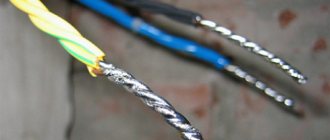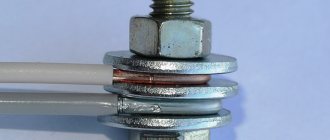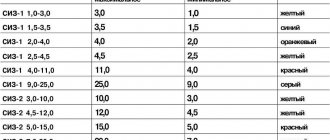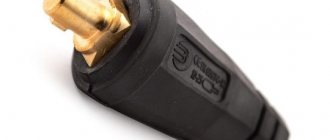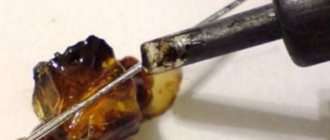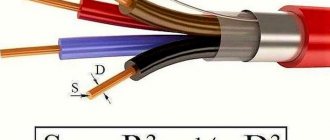We will not prove to you that twisting wires is a good connection method. Yes, it can be done well and insulated. It is also perfect as a temporary option. But according to the rules of electrical installations (PUE) in order to connect a wire or cable, ordinary twists are not recommended. Nevertheless, we will talk about it, and in very detail. Firstly, because, contrary to the PUE, most connections are made using this ancient “old-fashioned” method. Secondly, because correct twisting is the main stage of the most reliable methods of connecting wires - welding and soldering.
Where is electric twisting used?
Twisting of wires is performed to connect them electrically and mechanically. This connection method does not imply the transmission of high power. Therefore, they try to use twists only in low-current circuits and rooms without high humidity.
Connecting cables using twisting
Reliable twisting has the following properties:
- Low contact resistance. Otherwise the contact will burn out.
- High mechanical strength. Especially for wires suspended in the air.
- Tightness of the connection. When exposed to water, the twist oxidizes and burns.
- Conformity of metals of current-carrying conductors. Contact between copper and aluminum wires is not allowed.
Important! When installing electrical wiring in an apartment, the twists should be placed in junction boxes. This measure will protect the contact from dust and moisture and make it more accessible for maintenance.
PPE caps: why electricians constantly argue about them
The basis for creating an electrical contact here is the same twist, but it is performed in a short section and is reinforced by compressed coils of the spring, immediately closed with a dielectric cap.
Similar connectors came to us from the west. They are now widely used in frame construction: installation is easy and quick, and is stipulated by the rules.
At first glance, the design is ideal for an electrician: the work is done quickly and does not require much effort. But there are many complaints about PPE caps (insulated compression). Let's dwell on them.
The caps are not universal. They are created for a specific wire size. A thinner section will not allow the spring to compress the twist normally, although it is made in a conical shape.
Careless installers do the twisting using pliers, and simply put the cap on it as insulation. Since it is poorly secured by springs, it often flies off, exposing the metal under tension, which is dangerous.
Initially, the twisting must be prepared, but the main pressing force is created by springs when manually screwing the housing clockwise.
Simple PPE caps have an insufficiently strong spring and a satisfactory dielectric body. Manufacturers improved their shortcomings by releasing the SIZ-K model, specified by the technical specifications of the TU 3449-036-97284872-2007 series.
They allow you to mount three cores in one housing due to the use of a special galvanized spring with a rectangular cross-section profile, which has increased adhesion to the metal of the conductors.
Reinforced wings on the body facilitate installation and reduce the manual effort that must be applied when screwing. The design of the lower part of the skirt has increased protection of the contact connection.
The insulation of PPE caps is designed for voltages up to 600 volts.
However, many electricians try to use this design only in lighting networks with small current loads, for example, when using LED lamps.
Independent tests under maximum loads do not show reliable performance of PPE. In addition, the market is flooded with beautiful fakes made using simplified technology.
Why is twisting dangerous?
The main danger is high resistance. In addition, if the connection is poorly tightened or gets hot, then this indicator becomes even worse.
The twisting point acts as a low-resistance resistor. Under the influence of current, thermal energy is released on it. It promotes oxidation of the twist and further deterioration of the contact. As a result, the wires connected in this way simply burn out. Often this is what causes device breakdowns and wiring short circuits.
Burnt twist
Soldering or welding
The twisting of wires in the junction box will be reliable if it is soldered or welded. To do this you will need to use special tools and materials. After stripping the ends, they are twisted. The actions are similar to a simple twist. But after creating such a connection, the twisted ends are dipped into pre-molten solder. The cores are then lowered into the soldering bath. When the material has cooled, the attachment point needs to be additionally protected with cambric. You can also use electrical tape.
It is also permissible to use a soldering iron. But this method is almost impossible to use if you need to solder 3-4 cores with a standard cross-section (2.5 mm²). In this case, soldering can only be done if the tool has a thick copper tip. It must be characterized by high heat capacity. The power of the soldering iron must be at least 40 W (preferably 60 W).
It is worth noting that cooling the fixation area when using the soldering method in cold water is strictly prohibited. In this case, the fastening will be of poor quality. Microcracks appear in the material due to a sharp temperature change.
Pros and cons of using twists
Despite the risk of fire, twisting is very often used by electricians. This is explained by the advantages that this type of connection has:
- this is the cheapest way to connect wires;
- All you need is a knife and insulating tape;
- ease of manufacture;
- takes up minimal space.
Twisting is the easiest way to connect wires.
There are also disadvantages:
- such a connection is prohibited by the rules of the PUE;
- risk of fire;
- Twisted wires are difficult to separate.
How to make a wiring connection correctly
Connecting wires is required everywhere in rooms, in cars, devices and mechanisms, wherever there are wires. Today the following methods are used:
- Twisting;
- Welding;
- Soldering;
- Using special blocks, terminal blocks;
- Using self-clamping terminal blocks;
- Using PPE caps.
Further in the article we will talk about the simplest way to connect wires - twisting; any home craftsman will be able to put it into practice, for example, when installing temporary wiring is required.
Types of twists
There are dozens of twist options. They differ in the structure of current-carrying conductors, material and complexity of manufacture. If we consider from the point of view of purpose, twists are divided into 2 categories:
- Branch. The 1st wire remains intact. Only a piece of insulation is removed from it. Another wire is wound onto the bare current-carrying wire.
- Extension. Used to connect the free ends of 2 wires of the same cross-section. Cables are lengthened in this way.
Stranded wire branch
Where are stranded wires used?
Any stranded conductor contains at its base a large number of thin wires. The use of a multi-core cable is important in areas that require a large number of bends or, if necessary, to pull the conductor through holes that are too narrow and long enough.
The scope of application of stranded conductors is presented:
- extended tees;
- mobile lighting devices;
- automotive wiring;
- connecting lighting fixtures to the electrical network;
- connecting switches or other types of levers to influence the electrical network.
Flexible stranded conductors can be twisted repeatedly and easily, which does not negatively affect the functionality of the system. Among other things, this particular type of electrical wiring is distinguished by plasticity, and greater flexibility and elasticity is imparted to the wire by weaving a special thread, which in strength and composition is a bit like nylon.
Wiring connection tool
Twisting requires a minimal set of tools. First, you need to remove the insulating layer from the cable. A knife or wire cutters are suitable for this. It is most convenient to use a special tool - a stripper. Next, the stripped wires are twisted. If the wire is single-wire, it is advisable to tighten them with pliers. The last stage is sealing the connection. To do this, you should use insulating heat-shrinkable tubes or PVC tape.
Wire Stripper
How to connect headphone wires
It is recommended to repair broken cables by soldering. To do this, perform the following steps:
- Cut off the damaged piece. Remove the braid by 2-3 cm. The number of cores depends on the type of headphones. The simple device has 4 wires insulated with multi-colored rubber. A twisted pair cable consisting of grounding and signal cables is connected to the microphone. The first one is covered with yellow insulation.
- After stripping all the conductors, twist the copper hairs. Burn the contacts with a lighter, removing the varnish coating. It not only prevents soldering, but also impairs current conduction.
- Treat bare areas with tin. Heat shrink tubing is placed over the wire braid. The same material is used to insulate each core.
- Tinned sections are twisted taking into account the color of the insulation. The connections are heated with a soldering iron until the tin is evenly distributed.
- Check that the work is being done correctly. When sound appears in the speakers, a bandage is applied to the repaired area. To do this, put heat-shrinkable tubes on the twists and heat them with fire. Insulation prevents short circuits.
- Tie the wiring harness together with a thread and slide the thick heat-shrinkable tube that was put on earlier.
Preparing for twisting
Before twisting, it is necessary to remove the layer of protective insulation from the current-carrying conductors. Usually this operation is performed using a knife. During operation, you should try not to damage the metal current conductor with the tool blade. Otherwise, it is capable of breaking in a weak spot. This is especially true for soft stranded cable cores.
If you are going to remove the insulation from an aluminum cable, you must avoid kinking it. This metal does not cope well with frequent deformations. Therefore, an aluminum cable can break during stripping.
Removing the insulation from the cable
Note! Aluminum wire can break even under insulation. This usually happens within 20 cm of the connection. This problem cannot be identified visually. The break is looked for by touch.
Advantages and disadvantages
Weaving wires together is probably the oldest method of merging conductors together. However, over time, the power of devices requiring high currents also increases. Twisting, as a rule, is not designed for them, but for home use it is very appropriate.
It is worth mentioning that this wiring option cannot be used with devices such as electric kettles, refrigerators, washing machines, heaters and fan heaters, electric stoves, and computers.
The main advantages of twisting are:
- speed of creation;
- durability (if done correctly);
- the ability to weave wires without additional tools;
- ideal for signal contact (in the absence of connecting high-current consumers);
- the ability to improve the connection using soldering;
- cheapness;
- the ability to combine two, three, four wires simultaneously;
- Possibility of reconnection.
Its disadvantages include the following:
- the need for isolation;
- operability only with low-current consumers;
- inconvenient installation;
- fire hazard if work is performed incorrectly;
- a large number of nuances that MUST be taken into account when weaving wires;
- “surges” of voltage and interference on electrical appliances when the area is overloaded.
As can be seen above, twisting has a limited range of use; it cannot be used with powerful devices, and when used with computers, modern televisions, audio equipment and other equipment of the 21st century, there is a problem with the occurrence of interference and “throws”. Therefore, it is advisable to weave wires when used with lighting devices (chandeliers, lamps, etc.), power adapters and other “weak” devices.
Options for twisting stranded wires
In practice, 3 methods of twisting flexible stranded wires are used. The choice of method is made according to the situation and based on the preferences of the master. The methods are:
- serial connection;
- parallel connection;
- thin wire bandage;
Serial twisting
The stripped wires are applied to each other so that they form a crosshair. Then the conductors are twisted together. The connection made is symmetrical relative to the crosshairs. The ends of the wires stick out in opposite directions. After twisting, it is advisable to slightly tighten it so that it tightens.
The method is good due to the compactness of the resulting connection. Its thickness does not exceed 3 diameters of the insulated wire. Care must be taken. If the twist is protected from moisture by a heat-shrinkable tube, then the insulation is put on the core before making the connection.
Parallel
The insulation is removed from the ends of the wires. The cores should be connected so that the stripped sections are parallel. The ends of the wires point in the same direction. The current conductors are then wound onto each other in the shape of a spiral. It is important to make the connection as tight as possible, but not to break the conductors with excessive force.
This twist can be found in the junction box. To protect the contact, electrical tape or heat shrink is used. For temporary and non-essential connections, it is allowed to use a PVC pipe (cambric) for insulation.
Bandage twist
The banded connection of cores is suitable for connecting thick wires that are difficult to bend with your hands or pliers. Current-carrying conductors are laid next to each other. They must first be properly cleaned on all sides using a needle file or file. Then the bare wires are tightly wrapped in a circle with the maximum number of thinner wires. A similar connection is used on power transmission towers.
Important! Do not connect the cable cores in a knot. The contact will be as tensile as possible, but extremely unreliable from the point of view of electrical conductivity.
A common method is groove twisting
First, familiarize yourself with the sequence of steps on how to twist wires with your own hands. Bend the ends of the wire into small hooks, hook them together, and wind one wire around the other.
Insulate the resulting twist to ensure human safety, reliable contact, prevent current leakage and prevent short circuits.
Professionals say that these types of wire twisting can be made more durable by using the following recommendations:
Twisted contacts are additionally connected by soldering or welding, as a result the contact acquires maximum reliability and is almost impossible to break. It is preferable to use soldering when both wires of the connection have a large cross-section.
WAGO terminals greatly facilitate connection, making it more efficient; they are needed when you have to figure out how to twist copper wires with aluminum ones. The whole procedure will take place quite quickly, while the “vags” allow you to connect wires of different cross-sections, the contact will be reliable and durable.
If a home handyman is faced with the task of connecting wires in an electrical outlet or lamp, use WAGO terminal blocks.
Thanks to PPE clamps, the reliability of the connection increases significantly, making it as safe as possible. These products have a low price, so they are available at any electrical store.
- SIP wires: types, differences from cable, features and advantages
What is a Power Cable?
- How to conveniently unwind a cable coil on site during electrical installation
Wires twisted together should not be immediately closed using a junction box. It is better to observe how the electrical network works for several hours, after which it is recommended to check the temperature at the mounting location. If the connection gets very hot, you need to do everything again: most likely, the contacts are unreliable.
The twist itself is not waterproof, so it is better to take a box to connect the wires inside the wall; if without it, then the twist wires will need to be insulated using cambrics.
All you have to do is determine for yourself which twisting method is better and consider methods for isolating nodes.
Features of twisting single-wire wires
Single-core wiring is more difficult to twist than multi-core wiring. There are a number of reasons for this:
- The current-carrying core is made of a rigid metal rod. If the cross-section is large enough, then it will not be possible to bend it with your hands.
- The wire has low ductility. It is susceptible to kinks, so you need to work with it with extreme caution.
- When stripping insulation, the knife blade must be held at an angle of less than 30° to the axis of the wire. Otherwise, the tip will cut into the current-carrying core and damage it.
- Strippings are carried out no shorter than 50 mm. This is the only way to ensure a good connection.
- It is advisable to check the finished twist under load. During operation, it should not heat up more than a solid wire without a connection.
Method of connection with the bandage
You need to know how to twist the wires correctly in this case: you will also need to prepare a bare piece of wire.
Before connecting, the wires are stripped and placed side by side so that the stripped ends touch. Use the prepared additional piece for a bandage - use it to wrap the wires.
Connection of copper and aluminum conductors
The rules prohibit twisting copper and aluminum wires. However, in reality it is not always possible to follow such norms. If you decide to twist copper with aluminum, then you need to consider the following:
- The connecting twist must be easily accessible. Avoid touching the connection with flammable materials.
- Humidity increases the risk of curling. Water will accelerate oxidation, overheating and poor contact.
- The connection is not suitable for power circuits. You should not load it with more than 500 W.
- The resulting contact requires tightness. Moisture in the air will damage the twist.
- It is necessary to periodically monitor the connection status. It is better to replace the aluminum wire with a new one made of copper.
Bolted connection of copper and aluminum wires
Self-clamping terminal blocks
Self-clamping terminal blocks are a type of conventional terminal blocks. They provide an even faster connection because you don't even need to use a screwdriver.
The contacts in them are spring-loaded, so to connect the cables it is enough to insert the ends of the wires into the holes with the contacts.
During installation, you need to overcome the force of the spring, after which it will press the contact to the wire. It is noted that this method is very convenient for multi-core wires.
Among the disadvantages of such a connection is that the connection is not particularly reliable; it will not be difficult to pull out the wiring from the terminal block. This is especially true for single-core wires with a large cross-section.
A common disadvantage of terminal blocks is the possibility of moisture getting on the contacts, which can lead to their oxidation and damage.
Connecting wires of different cross-sections
Correct twisting is done with wires of equal thickness. In reality, this is not always possible. From time to time it is necessary to connect wires of different sections. Due to the different sizes of the wires, they will not be able to press properly. Therefore, it is advisable to solder the connection or use some type of terminal block or crimp sleeves.
A common case of such twisting is a branch in the electrical panel of a phase wire to an apartment. To increase reliability, the contact is improved with a “walnut” type connector. Its more professional, but less common name is branch compression.
Twisting method with winding
Strip the wires at the ends and bend them slightly in the middle, hooking the wires together at the bend. Next, alternately wrap the ends of one wire around the other.
To fix the windings and make the connection more reliable, use pliers, tighten everything and carefully insulate it.
Errors when making twists
Most errors are related to the shape, size and tension of the twist. To properly connect two wires, they should be wound evenly around each other. Between the current conductors there should be a maximum contact patch area. It is considered incorrect to wind one core onto another if they have a different cross-section.
Another mistake is twisting it too short. The longer it is, the larger the contact area. This means lower resistance and possible heating. The length of a good twist is at least 5 cm.
When making a connection, it is necessary to select the correct tension. Too much force can break the twist, and too little will lead to poor electrical contact.
When installing wiring, electricians often use various tightening devices. They are a bit with a special attachment for wires, which is inserted into any drill. This device turns the power tool into a semi-automatic wiring installation machine. It is possible to do it yourself. But it’s much easier to buy ready-made ones. For example, the screwdriver attachment from Tundra, in addition to connecting wires, is capable of removing insulation.
Method - twisting wiring with protected ends
Expose the wires by at least 5 cm, cross the ends not protected by insulation, clamp the resulting cross with pliers and twist them together using a rotational movement.
Bend the resulting twist so as to direct it parallel to the wire, and insulate everything.
Insulation methods
Cable connections without insulation are unsuitable for operation. To complete the twisting, it must be protected from the external environment. To do this, you need to select one of the insulating materials:
- rag or PVC electrical tape;
- heat-shrinkable tubes;
- connecting insulating clamp (PPE).
Insulation using PPE caps
Insulating tape is the oldest and most familiar option to every installer. Heat shrink tubing is convenient. Their main advantage is compactness. PPE is the fastest method of isolation. They are made in the form of caps placed on the bare ends of the wires.
Note! There are 2 types of electrical tape: PVC-based and rag. What to choose should be determined based on the situation. PVC tape is more airtight and easier to work with. But it does not stick well in the cold and is capable of unwinding itself from the twist. Cloth tape performs better in the cold. But it is easily soiled and can become saturated with water.
The PUE does not consider twisting as a permitted method of connecting wires. However, such a connection is extremely common in low-current circuits. Without knowing how to twist correctly, you will not be able to connect the cable securely.
Insulating twists with electrical tape
A good twist has minimal contact resistance. The contact should be as strong and tight as possible. If you twist the wires in compliance with these rules and no large current flows through the contact, then it will last for decades.
Additional technological operations
Since the PUE prohibits twisting alone, and it is impossible to connect different materials, the twisting process must end with a terminal block or soldering. To make the connection reliable, the following technological operations are used:
- soldering;
- welding;
- screw terminals;
- crimping in special spring devices;
- crimping.
Soldering and welding when connecting
The only drawback of this operation is the labor intensity of the work. To perform soldering you will need tin and flux. When working with copper, rosin is used as a flux, while for aluminum, highly active fluxes containing oleic acid and lithium iodide are used. If a soldering iron with a power of up to 100 W is enough for soldering copper, then aluminum is welded using a gas heater, the heating temperature should be 400-500 degrees. Solder for copper is lead-tin. And for aluminum containing zinc.
The technology itself is simple, since the thermal conductivity of twisting is greater than that of solder, when melted it transfers to the joint, creating a thin layer. When soldering, large amounts of solder are not allowed; it should be distributed evenly over the entire surface.
Application of screw terminals
Screw clamps, in their operating principle, involve mechanical compression of twisted surfaces using a bolted connection. For this, steel pads are used. The finished twist or individual wire strands are placed under a steel washer and compressed by screwing in a screw. In this case, the clamping is carried out both by the washer itself and only by the screw. The first method is better, since the contact surface is larger.
The terminal block itself looks like a plate on an insulator with a group of contacts. Using terminal blocks, both copper and aluminum wires of different sections are connected.
Using spring devices
Allows for the fastest connections without the use of tools. Wago terminal blocks are widely used. They are produced not only in different sizes, but also for different numbers of connected wires. With their help, single-core and multi-core wires of different sections and types are connected. The wires are combined both individually and with each other. For this purpose, the terminal blocks have a latch-flag, which allows you to lay the wire and clamp it inside after latching. Or use a device in the form of clips.
Using the Wago terminal, you can connect aluminum and copper to each other. But for this, a special paste is used to prevent air from entering, and the wire strands are separated into separate cells.
Crimping of connected cords
If it is necessary to connect large cross-section wires, lugs (sleeves) are used. The wires are stripped and inserted into the sleeves, then the sleeve is compressed using press pliers and the wire is crimped. This connection is considered reliable, but requires specialized tools.
Connecting insulating clamps (PPE) are also considered a kind of crimping. After twisting the wire, depending on the diameter, the caps are screwed on top of the connection, pressing the contact and insulating it.
The last final step after making the connection is to carefully isolate it. Dielectric tape or thermal tube is used as an insulator. The insulation should be 2-3 cm larger than the junction itself. The insulation must be carried out efficiently, otherwise there is a possibility of a breakdown between the wires, which will lead to a short circuit.
Blog
Twisting wires is prohibited by the pros!
Not long ago, at one site in Minsk, I saw electricians who were twisting wires and smearing them into the walls. To my remark, they made excuses that they do everything that way. It turned out that the guys came from the region, and for them this method of connection is common practice - cheap and fast. For such “masters” I would like to remind you that twisting wires and leaving them like that is IMPOSSIBLE!
According to technical standards in the Republic of Belarus, ordinary twisting in electrical wiring is prohibited:
Indeed, the PUE does not allow the use of twisting to connect wires. However, copper twisting, if done by a professional craftsman, can easily support a load of 16 A, without any negative consequences. If the load is greater, the contact will deteriorate and burn out over time.
Important
There is another interesting paradox here: despite the fact that twisting is heavily criticized, all the burned twists that I have seen were not done professionally. Most of them were aluminum. Aluminum is generally a very capricious conductor; it behaves poorly in any connection and requires special attention. But even such twists can cope with household loads in apartments.
However, despite this, twists are evil. Why?
Firstly, they have a high transition resistance and secondly, they are very sensitive to pulse currents. In addition, not everyone knows how to do twists correctly.
What should the twist be? The correct twist should be 3-5 cm long (depending on the cross-section and number of strands - the thicker and larger, the longer), twisted tightly but “without wings”.
Typical mistakes when twisting:
In the photo, I tried to imitate the incorrect wire connections that I encountered in apartment wiring:
- Option a) – insufficient twist length.
- Options b) and e) are not twists at all, but they are one of the most favorite connections of homemade “crazy people”.
- Options c) and d) – untwisted and poorly twisted twists.
Another of the most common types of connections is twisting an aluminum core with a copper one:
and connection of a mono core and a stranded wire:
All this is an example of bad connections. It is IMPOSSIBLE to use such connections in electrical wiring!
Where can you use WIRES TWISTING?
I use regular wire twisting only as a temporary connection or as a preparatory operation for other types of connections (for example, for welding or soldering).
Summary: Twisting is bad! Use reliable types of connections: welding, crimping, 3M clamps.
